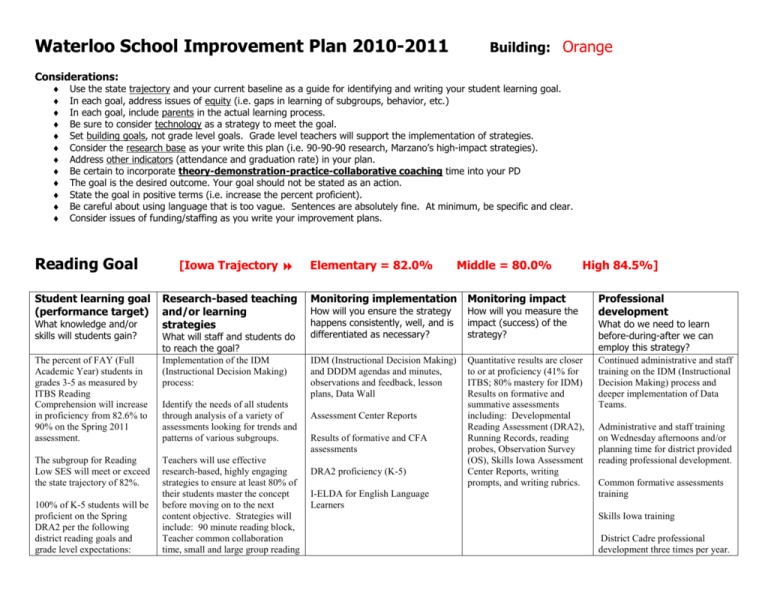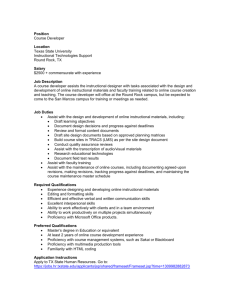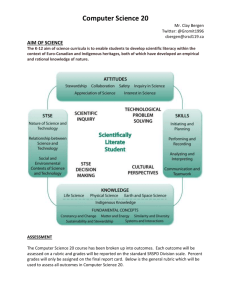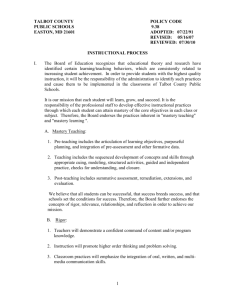Bunger 2006 Building School Improvement Plan for Math
advertisement

Waterloo School Improvement Plan 2010-2011 Building: Orange Considerations: Use the state trajectory and your current baseline as a guide for identifying and writing your student learning goal. In each goal, address issues of equity (i.e. gaps in learning of subgroups, behavior, etc.) In each goal, include parents in the actual learning process. Be sure to consider technology as a strategy to meet the goal. Set building goals, not grade level goals. Grade level teachers will support the implementation of strategies. Consider the research base as your write this plan (i.e. 90-90-90 research, Marzano’s high-impact strategies). Address other indicators (attendance and graduation rate) in your plan. Be certain to incorporate theory-demonstration-practice-collaborative coaching time into your PD The goal is the desired outcome. Your goal should not be stated as an action. State the goal in positive terms (i.e. increase the percent proficient). Be careful about using language that is too vague. Sentences are absolutely fine. At minimum, be specific and clear. Consider issues of funding/staffing as you write your improvement plans. Reading Goal Student learning goal (performance target) What knowledge and/or skills will students gain? The percent of FAY (Full Academic Year) students in grades 3-5 as measured by ITBS Reading Comprehension will increase in proficiency from 82.6% to 90% on the Spring 2011 assessment. The subgroup for Reading Low SES will meet or exceed the state trajectory of 82%. 100% of K-5 students will be proficient on the Spring DRA2 per the following district reading goals and grade level expectations: [Iowa Trajectory Research-based teaching and/or learning strategies What will staff and students do to reach the goal? Implementation of the IDM (Instructional Decision Making) process: Identify the needs of all students through analysis of a variety of assessments looking for trends and patterns of various subgroups. Teachers will use effective research-based, highly engaging strategies to ensure at least 80% of their students master the concept before moving on to the next content objective. Strategies will include: 90 minute reading block, Teacher common collaboration time, small and large group reading Elementary = 82.0% Middle = 80.0% High 84.5%] Monitoring implementation Monitoring impact How will you ensure the strategy happens consistently, well, and is differentiated as necessary? How will you measure the impact (success) of the strategy? IDM (Instructional Decision Making) and DDDM agendas and minutes, observations and feedback, lesson plans, Data Wall Quantitative results are closer to or at proficiency (41% for ITBS; 80% mastery for IDM) Results on formative and summative assessments including: Developmental Reading Assessment (DRA2), Running Records, reading probes, Observation Survey (OS), Skills Iowa Assessment Center Reports, writing prompts, and writing rubrics. Assessment Center Reports Results of formative and CFA assessments DRA2 proficiency (K-5) I-ELDA for English Language Learners Professional development What do we need to learn before-during-after we can employ this strategy? Continued administrative and staff training on the IDM (Instructional Decision Making) process and deeper implementation of Data Teams. Administrative and staff training on Wednesday afternoons and/or planning time for district provided reading professional development. Common formative assessments training Skills Iowa training District Cadre professional development three times per year. Kdg at 3; 1st at 16; 2nd at 28; 3rd at 38; 4th at 40; 5th at 50. 100% of the students in grades 3-5 will score at the proficiency level on writing prompts used as a part of the Science Writing Heuristic (SWH) approach. The 5th grade students will show improvement as measured by the pre/post Cornell Critical Thinking Test. instruction, Marzano’s Effective Instructional Strategies, Active Boards, Parent Involvement activities (i.e. Read-a-MillionMinutes Program, parent newsletters), Explicit Instruction (Modeling)–Gradual Release of Responsibility, Reading Daily Warm-Ups activities supporting national and state standards, Daily Five, Words Their Way (grades 25), Differentiated Instruction, and implement the use of Writing Skills as defined in the GHGR. Students not achieving mastery during classroom instruction will receive Tier 2 Supplemental Instruction (outside of core instructional time) such as: scheduled intervention blocks, paraprofessional support, Special Needs inclusion when applicable, peer tutoring. Students who fail to reach mastery after Tier 2 will continue to work toward mastery in Tier 3-Intensive Instruction. Teachers will develop and utilize formative assessments at the classroom, grade level, and district level. SWH--Teachers will video tape one lesson per semester. Graduate students from U of I will provide monthly support and technical assistance to teachers to increase implementation. The Elementary Curriculum Coordinator and principal will conduct walkthroughs to support implementation. SWH--Results from Cornell Critical Thinking Test; ITBS reading comprehension and science scores; walkthroughs; lesson plans; video taped lessons, teacher responses to coaching/reflective questions. SWH--The 3-5 grade teacher teams will participate in 4-5 days of training during the summer of 2010. Additional 2-3 days of follow-up support will be provided to the teams throughout the school year. Math Goal Student learning goal (performance target) What knowledge and/or skills will students gain? The percent of FAY (Full Academic Year) students in grades 3-5 as measured by the ITBS Math Total will increase in proficiency from 83.2% to 90% on the Spring 2011 assessment. 100% of students in grades 15 will be proficient on the quarterly Basic Facts Assessments. 100 percent of K-5 students will be proficient on End of Year Math Test. 100% of the students in grades 3-5 will score at the proficiency level on writing prompts used as a part of the Science Writing Heuristic (SWH) approach. The 5th grade students will show improvement as measured by the pre/post Cornell Critical Thinking Test. [Iowa Trajectory Research-based teaching and/or learning strategies What will staff and students do to reach the goal? Implementation of the IDM (Instructional Decision Making) process: Identify the needs of all students through analysis of a variety assessments looking for trends and patterns of various subgroups. Teachers will use effective research-based, highly engaging strategies such as: 70 minute math block, Teacher common collaboration time, small and large group instruction, Marzano’s Effective Instructional Strategies, Active Boards, Parent Involvement activities (TIPS: Teachers Involve Parents in Schoolwork; parent newsletters, Parent-Led Conferences), Math Daily WarmUps activities supporting national and state standards, Mental Models, manipulatives, small group math instruction, and Explicit Instruction (Modeling)GRR (Gradual Release of Responsibility). Students not achieving mastery during core instruction will receive Tier 2-Supplemental Instruction (outside of core classroom time) such as: scheduled intervention blocks, paraprofessional support, Special Needs inclusion when Elementary = 81.0% Middle = 79.0% High 84.5%] Monitoring implementation Monitoring impact How will you ensure the strategy happens consistently, well, and is differentiated as necessary? How will you measure the impact (success) of the strategy? DDDM (Data Driven Decision Making) minutes, observations and feedback via walkthroughs and coaching/reflective questioning, lesson plans Quantitative results are closer or to proficiency. IDM (Instructional Decision Making): proficiency levels on Core Instruction, Supplemental Instruction, and Intensive Instruction will be monitored Assessment Center Reports, Weekly DDDM (Data Driven Decision Making) minutes, observations and feedback, lesson plans The ALEKS program (an individualized online computer math program) will be incorporated for grades 3, 4 and 5 for students who are advanced and for those in need of assistance. SWH--Teachers will video tape one lesson per semester. Graduate students from U of I will provide monthly support and technical assistance to teachers to increase implementation. The Elementary Curriculum Coordinator and principal will conduct walkthroughs to support implementation. Results on formative assessments including but not limited to: pre and post tests, beginning and end of year grade level tests, quarterly basic facts, FASTT Math (Fluency and Automaticity through Systematic Teaching with Technology) reports, classroom, grade, and district formative assessments, Skills Iowa Assessment Center reports SWH--Results from Cornell Critical Thinking Test; ITBS reading comprehension and science scores; walkthroughs; lesson plans; video taped lessons, teacher responses to coaching/reflective questions. IDM: Data Team minutes and Data Walls will reflect proficiency levels Professional development What do we need to learn before-during-after we can employ this strategy? Administrative and staff training on the IDM (Instructional Decision Making) process and deeper implementation of Data Teams Administrative and staff training on Wednesday afternoons and/or during planning time, district provided math professional development CFA (Common Formative Assessment) training Skills Iowa training SWH--The 3-5 grade teacher teams will participate in 4-5 days of training during the summer of 2010. Additional 2-3 days of follow-up support will be provided to the teams throughout the school year. applicable, peer tutoring. Students who fail to reach mastery after Tier 2 will continue to work toward mastery in Tier 3-Intensive Instruction such as: scheduled intervention blocks, paraprofessional support, Special Needs inclusion when applicable, peer tutoring. The ALEKS online math computer program will be utilized for students in grades 3, 4 and 5 for advanced as well as for those in the lower spectrum. Climate/Culture Goal Student learning goal (performance target) What knowledge and/or skills will students gain? 100% of staff, students and parents identify Orange Elementary as a school demonstrating an environment of mutual respect as measured by the end of year climate survey. Engage in the second year implementation process of the Positive Behavioral Interventions Supports (PBIS). Research-based teaching and/or learning strategies Monitoring implementation Monitoring impact How will you ensure the strategy happens consistently, well, and is differentiated as necessary? How will you measure the impact (success) of the strategy? Teaching of building expectations at beginning of year and midyear Review of climate survey Results of Spring 2010 survey and post climate survey Spring 2011 What will staff and students do to reach the goal? Continue building committee team Monthly PBIS Committee meetings (agendas, minutes) Implement building expectations for PBIS Plan Collect base-line data for referrals. Decrease office referrals by 25% Continue implementation of Second Step , A Violence Prevention curriculum Infuse the Six Pillars of Character Program into our PBIS Program Review survey results Monthly staff meetings to review baseline data for the development of Tableau data Quarterly PBIS newsletter to families including base-line data Observations and feedback, lesson plans Observations and feedback, character grams, monthly assemblies, Kid of Character Luncheons (selected K-5) at Orange and Hawkeye Community College (selected 4th and 5th graders) What do we need to learn before-during-after we can employ this strategy? Ongoing PBIS training of building committee, staff, and students District Coaches meetings Results of self assessment survey Staff to take self assessment PBIS survey at beginning of year Professional development End of year base-line referral data (Tableau data) Spring SET (School-Wide Evaluation Tool) evaluation Number of students in Tiers 1-3 Advocate our mission, vision, and value statements as developed through staff input Post mission, vision, values in classrooms and throughout the building; model, observations, lesson plans Continue the implementation of our building Wellness Plan Committee meetings (agendas, minutes) Continue parent communication Connect-Ed, parent newsletters (including Home Connection), ParentLed Conferences, Parent-Teacher Conferences, committee membership, Site Council, Orange Parent Association, Partners in Education, Volunteers, Infinite Campus, Report Cards Tableau Reports Dates for review during the 2010-2011 school year Date of review Persons involved in the review Progress toward the goal (results thus far)






